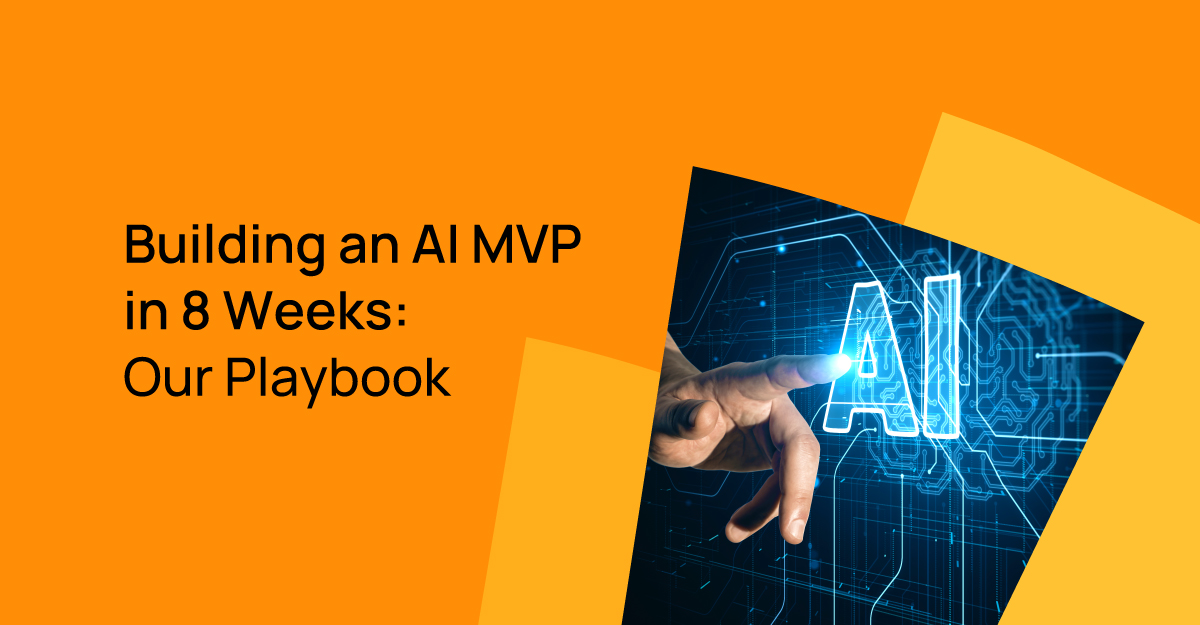If you're a SaaS founder sitting on an AI idea, chances are you've already asked yourself:
“Can I validate this quickly without burning through my entire seed round?” You’re not alone, by the way.
In the past 18 months, we've worked with startups and enterprise innovation teams across the US, EU, and India to ship AI-driven MVPs in less than 8 weeks.
This post outlines how we approach it, the frameworks we follow, and the lessons we’ve learned along the way that you don’t need a 20-person team to build an AI MVP.
You need clarity, a lean crew, and a roadmap that favors momentum over perfection.
Week 0: Clarity Over Complexity
Before a single line of code is written, we spend time clarifying one simple thing:
What does "intelligence" mean in the context of your product?
We sit with your team to define:
- The core user journey that needs automation, augmentation, or prediction
- The data sources you already have (or can simulate)
- The success metric for MVP (e.g., 80% accuracy in classification, or <2s response time for a chatbot)
No vague "AI magic," just focused outcomes.
Example: For a German HR SaaS client, intelligence meant detecting tone in employee feedback and classifying sentiment with 75% accuracy. That was our benchmark. That was the build.
Week 1–2: Architecture and Prototyping
Our goal in this phase: Make it real enough to test, but lean enough to pivot.
We design the system architecture with two key principles:
- Separation of intelligence and interface
- Plug-and-play ML modules (often starting with pre-trained models or APIs like OpenAI, Hugging Face, or Vertex AI)
Once scoped, we spin up a small but specialized pod, usually:
- 1 AI/ML Engineer
- 1 Full-Stack Developer
- 1 Product Owner (on our side)
- You (with feedback!)
We often use streamlit, Flask, or lightweight microservices to create clickable + functional prototypes by the end of Week 2.
This architecture-first mindset is core to our AI ML development services, which prioritize speed without sacrificing flexibility.
Week 3–5: Intelligence That Works
This is the core of your AI MVP. We take your datasets, CSV dumps, call logs, screenshots, or anything else you have and begin the model training & tuning loop.
Our approach here is pragmatic:
- If off-the-shelf APIs solve it, we use them.
- If they don’t, we build lightweight custom models using Scikit-learn, TensorFlow Lite, or fastai.
We also embed guardrails from the start, like response thresholds, fallbacks, and explainability logs. You don’t want your MVP doing things you can’t explain to users (or investors).
Case in point: One client’s AI suggestion engine was overfitting to extreme product reviews. We caught it early through a bias check built into our pipeline and corrected the training logic.
Week 6: Test Like It's Production
You may be building an MVP, but your users don’t care. If it breaks, it breaks. If it's slow, it's useless.
So we test it like it's already live. In this phase, we:
- Deploy to a UAT or sandboxed cloud instance
- Run structured test cases on functionality and accuracy.
- Simulate data spikes and concurrent usage.
- Collect qualitative feedback from your early users.
This is when most pivots happen: UI tweaks, model threshold tuning, or edge-case handling.
Week 7–8: Polish & Deploy
With the feedback loop in, we do a final round of cleanup:
- UI/UX refinement
- Deployment to a scalable environment (AWS, Azure, or your infrastructure)
- Documentation and internal handoff
We also help you set up usage dashboards so you can track adoption, accuracy, and user behavior from Day 1.
By the end of Week 8, you’re not sitting with a Figma wireframe. You have a working product demo. Something you can pitch. Pilot. Or show to customers.
And that’s the hallmark of any successful AI software development engagement—tangible outcomes over theoretical success.
Optional: What Happens After
We keep the next stage flexible:
- Some teams raise funds and come back for a Phase 2 build
- Some internal innovation teams use the MVP to secure buy-in for enterprise rollout.
- A few pivot entirely, and that’s okay. Because now they know what works.
Lessons We’ve Learned (So You Don’t Have To)
- Don’t start with “AI.” Start with a real workflow that needs help.
- Data quality beats data quantity. 10 clean examples > 1000 noisy ones.
- You don’t need complex infrastructure to test a smart idea.
- Speed matters more than polish in early builds.
- Clarity kills scope creep. Define “done” before you begin.
Final Thought
If you're sitting on a solid product idea, don’t let the buzzwords or budget paranoia stop you.
You don’t need to be Google. You just need to validate fast, learn early, and build smart. That’s exactly what we help our clients do across industries, across time zones, and stages of maturity.
If you're building something in AI or planning to drop me a line. Happy to share a playbook, a prototype, or even just a second opinion.



